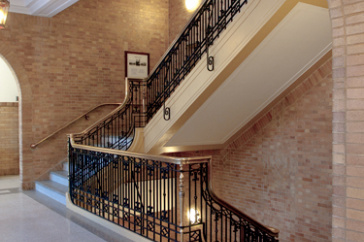UNH Completes Renovation of First Campus Building to Seek LEED Certification

The renovation of James Hall restored many important architectural characteristics, including the central stairway.
DURHAM, N.H. - A celebration last night (April 21, 2010) marked the completed renovation of James Hall, the University of New Hampshire's first building to seek LEED certification. Home of the departments of Earth sciences and natural resources and the environment, James Hall should receive at least LEED (Leadership in Energy and Environmental Design) Silver designation from the U.S. Green Building Council. The $33.8 million renovation was supported by the KEEP-NH (Knowledge Economy Education Plan) capital improvements initiative.
UNH collaborated with Shawmut Construction and Design and EYP Architecture and Design on the renovation, which began in August 2008 and finished in January 2010.
"James Hall has taken the university's commitment to sustainability one step further. I am proud that it will be the first academic building in our university system to obtain LEED certification for its environmentally responsible use of materials and its efficient energy and water systems," says Joe Klewicki, dean of the College of Engineering and Physical Sciences at UNH, within which the Earth sciences department falls.
"This outstanding new facility is consistent with our historic underlying commitment to principles of resource conservation, sustainability, and science-based ecosystem management. It will provide a wonderful foundation from which to advance our teaching, research and outreach programs as we literally and figuratively build for the future," says Jon Wraith, associate dean of the College of Life Sciences and Agriculture, within which the department of natural resources and the environment (NREN) falls. "We're all thrilled with this renovation, which provides significant advancement in our abilities to train tomorrow's scientists and managers, and we look forward to enhanced cross-college synergies between the NREN and Earth sciences departments."
Energy-saving innovations in James Hall include a gray water system that captures rainwater from the building's roof and gutters for use in toilets and urinals; daylight harvesting, which utilizes sensors to turn off electrical fixtures when natural daylight provides adequate light; and a heat wheel recovery system, which makes the air handling unit extremely efficient. In addition, 20 percent of the materials used in the renovation consist of recycled content, and 30 percent of the materials were extracted and manufactured within 500 miles of Durham. Visitors to James Hall can monitor energy use live via an energy kiosk in the building.
"UNH has a well established commitment to energy efficiency, resource conservation and high quality facility construction," says Paul Chamberlin, assistant vice president for energy and campus development. "We are incorporating the lessons learned in going through the formal LEED certification process in our campus design and construction standards which will ensure future projects achieve the same outstanding results as the James Hall renovation."
Built in 1929 to house the chemistry department, James Hall - named for chemistry professor Charles James - had not undergone much renovation throughout its history, yet the "bones" of the building were intact. While the renovation increased the building's size by 14,000 square feet, it salvaged and restored many important architectural characteristics, including the central stairway and 75 percent of existing exterior walls, floors and roof, to maintain the character of the building.
Additional unique features of the renovation include a "green" roof that uses plantings to clean and conserve water; an outdoor "classroom" featuring a slate chalkboard from the original building; and an 1878 wooden New Hampshire geological relief map by Charles Hitchcock, restored by Professor Emeritus of geology Wally Bothner.
The University of New Hampshire, founded in 1866, is a world-class public research university with the feel of a New England liberal arts college. A land, sea, and space-grant university, UNH is the state's flagship public institution, enrolling 12,200 undergraduate and 2,200 graduate students.
-30-
Multimedia:
Watch a video of the James Hall renovation: http://vimeo.com/8995719
Watch a video of the Hitchcock Map renovation: http://vimeo.com/8972779
Photographs available to download:
/unhtoday/news/cj_nr/2010/apr/bp22james_02.jpg
Caption: James Hall, built in 1929, is the University of New Hampshire's first building to seek LEED certification.
Credit: Perry Smith, UNH Photographic Services
/unhtoday/news/cj_nr/2010/apr/bp22james_01.jpg
Caption: The renovation of James Hall restored many important architectural characteristics, including the central stairway.
Credit: Lisa Nugent, UNH Photographic Services
/unhtoday/news/cj_nr/2010/apr/bp22james_03.jpg
Caption: As part of the James Hall renovation, Professor Emeritus of geology Wally Bothner restored a unique 1878 wooden New Hampshire geological relief map by Charles Hitchcock.
Credit: Perry Smith, UNH Photographic Services
/unhtoday/news/cj_nr/2010/apr/bp22james_04.jpg
Caption: The renovation of James Hall, the first building project at UNH to seek LEED certification, retained the signature yellow brick interior walls.
Credit: Perry Smith, UNH Photographic Services
Latest News
-
July 2, 2024
-
June 18, 2024
-
June 18, 2024
-
May 17, 2024
-
May 14, 2024

















































